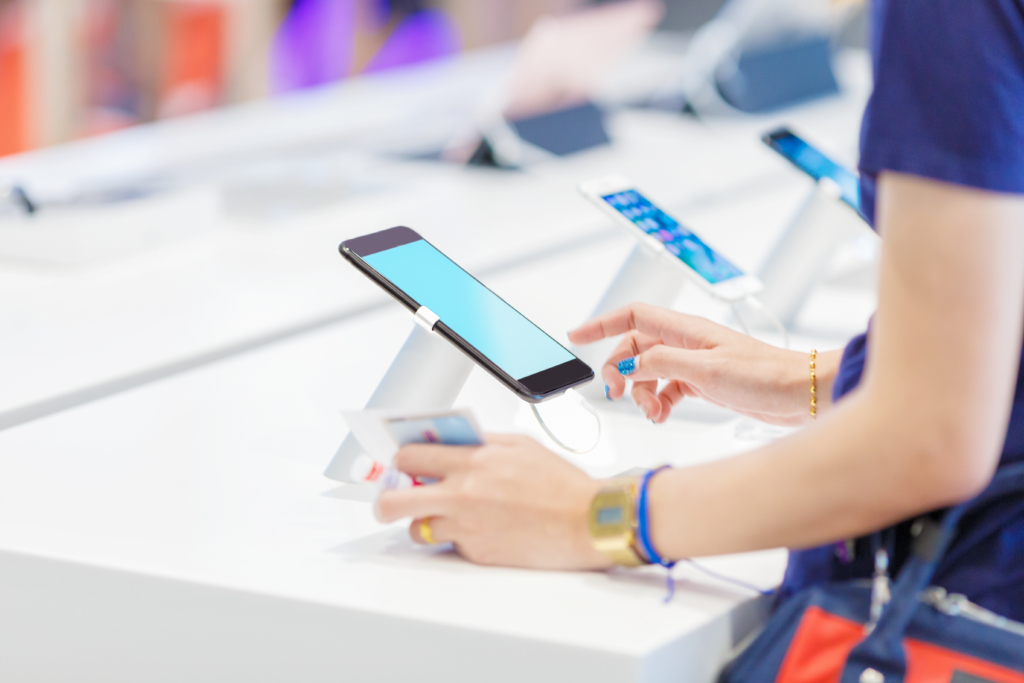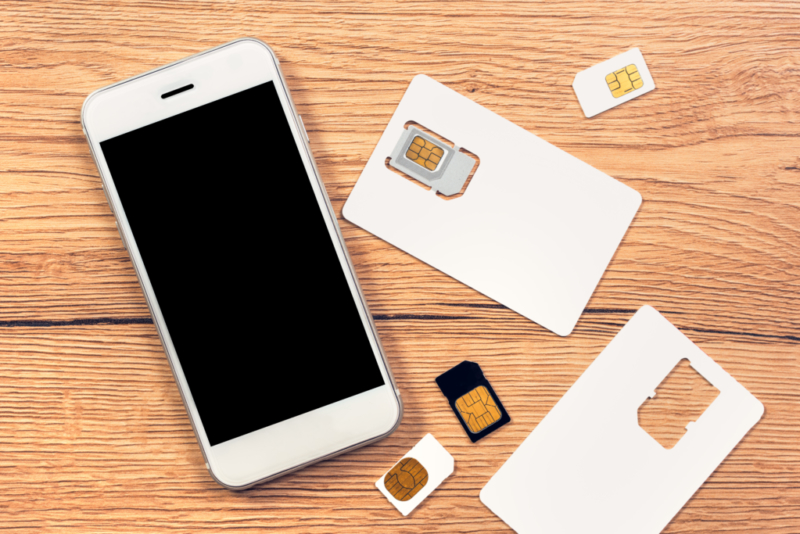Cell phones and smartphones have become indispensable to everyday life. They’re one of the first things people want to get when they start living abroad. Unfortunately, Japan’s mobile phone service is incredibly convoluted. That’s why, in this article, we’ll go through everything that you need to know to start using a cell phone or smartphone in Japan.
What Do You Need to Get Started?

Similar to almost every other country in the world, you will need both a smartphone/cell phone and a SIM card. There are two ways you can obtain these:
- Sign a Contract with a Major Carrier for a New Smartphone and/or SIM Card
If you’re looking to buy a new smartphone and/or SIM card, this is one possible option. The three biggest Japanese carriers are NTT docomo, au, and SoftBank. In Japan, most major carrier SIM card plans are bundled with a smartphone or other device. In most cases, the phone you’ll get from them after signing a contract will be SIM locked, meaning it will only work with a SIM card provided by the carrier. Only need the SIM card? Just opt out of any bundle plans.
Pros:
- Because all the major carriers have private networks, they can provide high-quality calls and fast and stable internet connections.
- Major carriers have stores all over Japan, so customer support is readily available.
- Most major carriers offer a multitude of services, often free, in case something goes wrong.
Cons:
- The monthly costs can be high.
- A typical contract is renewed automatically after two years. If you want to get out of the contract before that, you’ll have to pay a cancellation fee.
- You can’t switch to another carrier without unlocking your phone, even if you end your contract with them. Thanks to a law passed on May 2015, carriers must unlock phones if asked to after 180 days have passed from the date of purchase*, but this can be a hassle.
* While this officially only applies to phones bought after May 2015, there are unofficial ways to get your phone unlocked if needed.
- Buy a Cheap SIM Card and/or Smartphone From an MVNO
“MVNO” refers to mobile virtual network operators, who buy access to other companies’ telecommunications networks to allow you to talk on the phone or use the internet. Because they don’t have to set up or maintain their own networks, MVNOs can provide this service for very low prices.
Pros:
- Monthly costs are low, and the phones themselves are cheap compared to major carriers.
- Few contract restrictions. After the minimum contract period has passed, you can often cancel your service without any additional costs.
- MVNO phone plans are often a lot more customizable than major carriers. If you need the bare minimum, you’re likely to save money by going with an MVNO.
Cons:
- The quality of calls and internet speed are generally worse than what you’d get with a major carrier.
- The cost of calls is normally high.
- Most MVNOs don’t have a physical store, so if you have any problems, it might be difficult to get through to customer support.
- You might not be able to use certain apps, websites, or online services if you don’t sign up for the SMS/text messaging option. This is because they require text message verification.
- Even if you sign up for the SMS/text messaging option, you still might not be able to use certain features of apps such as LINE, as those features are directly tied to major carriers. More on this in a later section.
As you can see, there are many pros and cons to consider here. However, if you’ll be staying in Japan for less than two years or for an unspecified amount of time, or you want to use your own device*, then a cheap SIM card from an MVNO is probably the best way to go.
* Some foreign devices will not work on Japanese networks. We’ll explain this in more detail in the next section.
Can You Use a Foreign Phone in Japan?

As long as your smartphone is not SIM locked, you should normally be able to use a Japanese SIM card with a foreign phone.
However, some foreign phones are incompatible with Japanese networks. To find out whether your phone will work here or not, look for the technical standard compliance mark on it. All smartphones bought in Japan will have it, but some foreign models will not. So, if you want to use your phone, make sure it has the mark.
According to the Act for Partial Revision of the Telecommunications Business Act of 2016, even phones without the technical standard compliance mark should be compatible with Japanese SIM cards if they have an FCC Certification/CE mark and comply with Japanese technological standards. However, devices without a technical standard compliance mark will only be able to use Wi-Fi, wireless LAN, or Bluetooth services for up to 90 days in Japan.
That’s why it’s a good idea for those who want to use their own device to visit an MVNO’s website and look for a list of phones that will work in Japan. Alternatively, you can bring your phone to a physical store and ask the staff to check its compatibility for you.

What Kinds of SIM Cards Are There?

There are three kinds of SIM cards available in Japan:
- Data-Only SIM Cards
These SIM cards allow you to browse the internet and nothing more. You can’t make calls or send SMS/text messages, but you do have access to equivalent online services and apps like Skype or LINE. You can also use IP phone services like 050 plus.
- Data and Texting SIM Cards
These allow you to browse the internet and send SMS/text messages. Many apps such as LINE require you to have SMS services enabled for identity verification purposes, as these services are tied to an actual phone number. These SIM cards are a little more expensive than data-only SIM cards, but they are recommended for people who want to use apps or services that require confirmation via SMS/text message*.
* Many websites and apps in Japan require confirmation via SMS/text message, so you are strongly encouraged to get this option.
- Data, Texting, and Calling SIM Cards
With these cards, you get all the services of a typical smartphone plan: internet, texting, and high-quality calls. If you use an MNP (Mobile Number Portability)*, you can also transfer your previous phone number to this card so that you don’t have to update your contact information.
* This service allows you to keep your old number even across different carriers. This may require an additional fee depending on the carrier.
Which SIM Cards Are the Best?

The following SIM cards are especially recommended for foreigners:
- IIJmio (MVNO)
IIJmio’s SIM card/smartphone services are provided by Internet Initiative, Japan’s first domestic internet service provider (ISP). It can be used in almost every region of Japan and is one of the most top-rated and cheap SIM card providers in the entire country. IIJmio’s SIM cards have low prices and stable, fast internet connections, which is why this MVNO has won awards for customer satisfaction. You can find English instructions for getting their SIM cards on the IIJmio website (link below).
Sample Plan:
- Initial payment: 3,000 yen
- Data-Only SIM Card (type D*), Minimum Start Plan (3 GB): 900 yen
- Data and Texting SIM Card (type D*), Light Start Plan (6 GB): 1,660 yen
- Data, Texting, and Calling SIM Card (type D*), Family Share Plan (12 GB): 3,260 yen
* Uses the NTT docomo network. To use the au network, opt for type A cards. Note that all data-only SIM cards are type D.
** All prices are without tax.
Official website
- LINE Mobile (MVNO)
LINE Mobile is a multi-carrier MVNO. One benefit of signing up with them is that using their own services such as LINE as well as several other social media sites/apps doesn’t count towards the monthly data cap! They also have an extremely simple fee chart that shows exactly how much your plan will cost depending on the type of SIM card you get and how much data you want. Furthermore, LINE Mobile is the only MVNO that’ll let you use all the functions on the LINE app. For all these reasons, their SIM cards are especially recommended for people who use text messaging and social media apps a lot.
Sample Plan:
- Initial payment: 3,400 yen
- LINE Data-Free (Basic Plan (500 MB Data SIM)): from 600 yen
- SNS (LINE, Twitter, Facebook) Data-Free (3 GB Call SIM): from 1,760 yen
- SNS Music Data-Free (LINE, Twitter, Facebook, Instagram, LINE MUSIC) (3 GB Call SIM): from 1,960 yen
* All prices are without tax.
Official website
- Sakura Mobile (MVNO)
This MVNO is one of the few companies in Japan that mainly cater to foreigners. They accept international credit cards as well as debit cards, so even those without a Japanese bank account can sign up with them. Their SIM card plans also do not have any minimum contract lengths, making them a great option for exchange students or people who don’t know how long they’ll be in Japan. Their customer support and website are entirely in English. While all this sounds great, one caveat of this convenience is that they charge higher rates than many other MVNOs.
Sample Plan:
- Initial payment: 5,000 yen
- Data-Only SIM Card (3 GB Data SIM): 1,980 yen
- Voice + Data SIM Card (3 GB Data SIM): 2,980 yen
* All prices are without tax.
Official website
Where to Buy a SIM Card From an MVNO

There are reportedly around 600 MVNOs in Japan, but the majority of them don’t have physical stores, so most people sign up for them online and receive their cards the following day in the mail.
However, their increasing popularity has now led to them being stocked at huge electronic retail stores like Yodobashi Camera or Bic Camera. Many of these stores offer multilingual customer support, making them popular among people who aren’t too sure of their Japanese.
To sign up for a SIM card with an MVNO, you’ll need a residence card (在留カード or equivalent) with an up-to-date address, a form of ID* like a special permanent resident certificate, a credit card registered in your name, and an e-mail address that you can quickly access.
* If your current address and the address on your ID do not match, you’ll also need a certified copy of your resident record (住民票) or a utility bill issued within the last three months.
Useful Phrases to Remember When Buying a SIM Card at a Store
- Shimu kaado no uriba wa doko desu ka? Could you point me to the SIM cards?
- Puripeido no shimu kaado wo kudasai. I’d like a prepaid SIM card.
- Tsuuwa to deeta wo tsukaitai desu. I’d like a Call and Data card, please.
Is It True That You Can’t Use LINE With an MVNO SIM Card?

Messenger apps like WhatsApp, Facebook Messenger, and Wechat have become indispensable smartphone tools for chatting via text messages, making free calls, leaving voicemail, sending pictures or video, group calls, or group video chats. LINE in particular is widely used in Japan, which is why the possibility of not being able to use it if you get a SIM card from an MVNO is such a big problem.
So, what’s the answer to the question? Well, it’s both yes and no.
As long as you opt in for SMS/text messaging, then you can create a LINE account. However, as long as you are not with a major carrier or LINE Mobile, you cannot add new contacts by looking them up by their ID or phone number. The reason for this is because the age verification check needed to use this function takes data from the major carriers, so if you’re with an MVNO, it won’t recognize you. LINE Mobile is an exception since it is owned by the same company who operates the LINE app, so they have your details.
This might seem like a big issue at first, but there are a couple of workarounds. For example, you can still add new contacts using QR codes. The restriction also only seems to be applicable for the LINE app, so you can still add new contacts and use the user search feature through your computer. So, really, it’s not as big of a deal as many people make it out to be!
With that, we conclude this guide to SIM cards in Japan. We hope that you will use this guide to find the SIM card that’s best suited to your needs!
If you want to give feedback on any of our articles, you have an idea that you’d really like to see come to life, or you just have a question on Japan, hit us up on our Facebook!
The information in this article is accurate at the time of publication.

